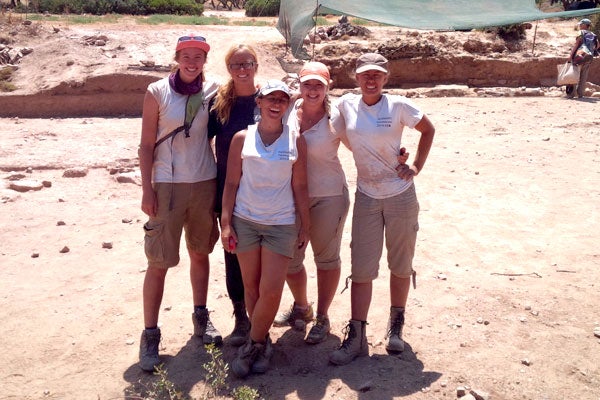
Archaeology students dig opportunity to get their hands dirty
Published: October 17, 2014
The trenches of an archaeological site on the Mediterranean island of Crete are a long way from the classrooms of the University of Toronto. But for a lucky group of students, those trenches provided an opportunity to learn things in a way that no textbook or lecture could.
The four students were searching for a Minoan palace, alongside U of T archaeologist Carl Knappett. An Aegean prehistorian specializing in Bronze Age Crete, Knappett directs an international team excavating at the site. This past July, he took the students along on a three week dig as part of the Faculty of Arts & Science Research Excursions Program.
“Everything I learned about doing archeology prior to this was theoretical,” said Kaitlyn Smid, a St. Michael’s College student studying archaeology and classical civilization. “It was helpful to use the tools I learned during my studies in a true excavation. I learned much more than I had expected.”
Crete was once the home of the earliest Bronze Age civilization in Europe and one of its most important settlements is Palaikastro, a large harbour town dating to this ‘Minoan’ period (c. 3000 – 1100 BC). Past excavations unearthed an extensive town but what has never been found is a central building, often called a “palace” in Minoan archeology. Considering that all Bronze Age towns on the island had such a building, Knappett is trying to determine if Palaikastro was different, or if they simply still have to find it.
“The students were able to see how the excavation informs our understanding of the site, and experience the excitement of how new finds are processed, analyzed, discussed and interpreted,” said Knappett.
The students worked as assistants, supporting trench supervisors with a range of tasks that included labelling and bagging “finds” as well as cleaning them for analysis.
“We spent a lot of time shovelling soil and taking it to the soil heap, to uncover the layers of soil from the time period we were looking for,” said Charlotte Scott, a St. Michael’s College student studying anthropology, archaeology and Aboriginal studies.
“You need to be able to notice changes in the soil, the texture, the colour and even the density when you’re excavating,” added Smid. “We really learned how to understand and engage with our surroundings to make sense of what we were seeing in the trench.”
Scott had just completed an introductory course on archaeology before leaving for Crete, and with everything still fresh in her mind, she enjoyed comparing the classroom version with observations of real archaeologists at work. “I found that the two lined up quite well.”
Knappett was compelled to participate in the Research Excursions Program for the entry point it provides to students. “Excavations almost always involve student training. Apprenticeship is a key part of the dig because digs do not happen all that often, and there’s no way you can acquire in the classroom the field skills needed to be an archeologist.”
And for Smid, the experience confirmed that. “Archeology and field research is something I really want to pursue in the future.”



